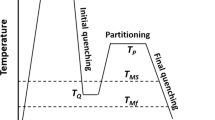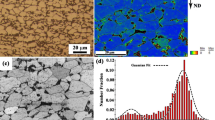Conclusions
-
1.
Austenite forming during the isothermal quenching of high strength cast iron VCh50 is metastable and transforms to martensite in the course of mechanical testing.
-
2.
The highest level of these or other properties of high strength cast iron is obtained at an optimal amount and stability of the austenite, which must be controlled by varying the isothermal quenching regimen.
Similar content being viewed by others
Literature cited
A. G. Vinitskii, L. S. Malinov, and B. B. Moshnyagul, “Increasing the wear resistance of regulating valve sleeves for the diesel 64N 25/34”, Tekhnol. Organiz. Priozvod., No. 1, 20–21 (1971).
M. P. Shebatinov, A. A. zhukova, and V. M. kOvalenko, “strength properties of high strength bainitic cast iron”, Vestn. Mashinost., No. 3, 61–63 (1986).
L. A. Solntsev, A. M. Zaidenberg, and A. F. Malyi, Production of High Strength Cast Iron [in Russian], Vyshcha Shkola, Kharkov (1986).
A. P. Cheilyakh, L. S. Malinov, and K. N. Sokolov, “The relationship of mechanical properties to the progress of the martensitic transformation during the testing of chrome — manganese steels”, Izv. Vyssh. Uchebn. Zaved., Chern. Metall., No. 4, 86–91 (1986).
F. S. Novik and B. Ya. Arsov, Optimization of Metal Manufacturing Processes by the Methods of Experimental Design [in Russian], Mashinostroenie, Moscow (1980).
L. S. Malinov, A. P. Cheilyakh, E. Ya. Kharlanova, et al., “The effect of isothermal quenching on the amount and stability of residual austenite and the properties of structural steels”, Metalloved. Term. Obrab. Met., No. 12, 12–15 (1989).
Additional information
Mariupol' Metallurgical Institute. “Azovmash“ Production Organization. Translated from Metallovedenie i Termicheskaya Obrabotka Metallov, No. 10, pp. 27–29, October, 1992.
Rights and permissions
About this article
Cite this article
Malinov, L.S., Cheilyakh, A.P., Malinov, V.L. et al. Effect of isothermal quenching on the properties and structure of high strength cast iron. Met Sci Heat Treat 34, 639–642 (1992). https://doi.org/10.1007/BF00776903
Issue Date:
DOI: https://doi.org/10.1007/BF00776903




